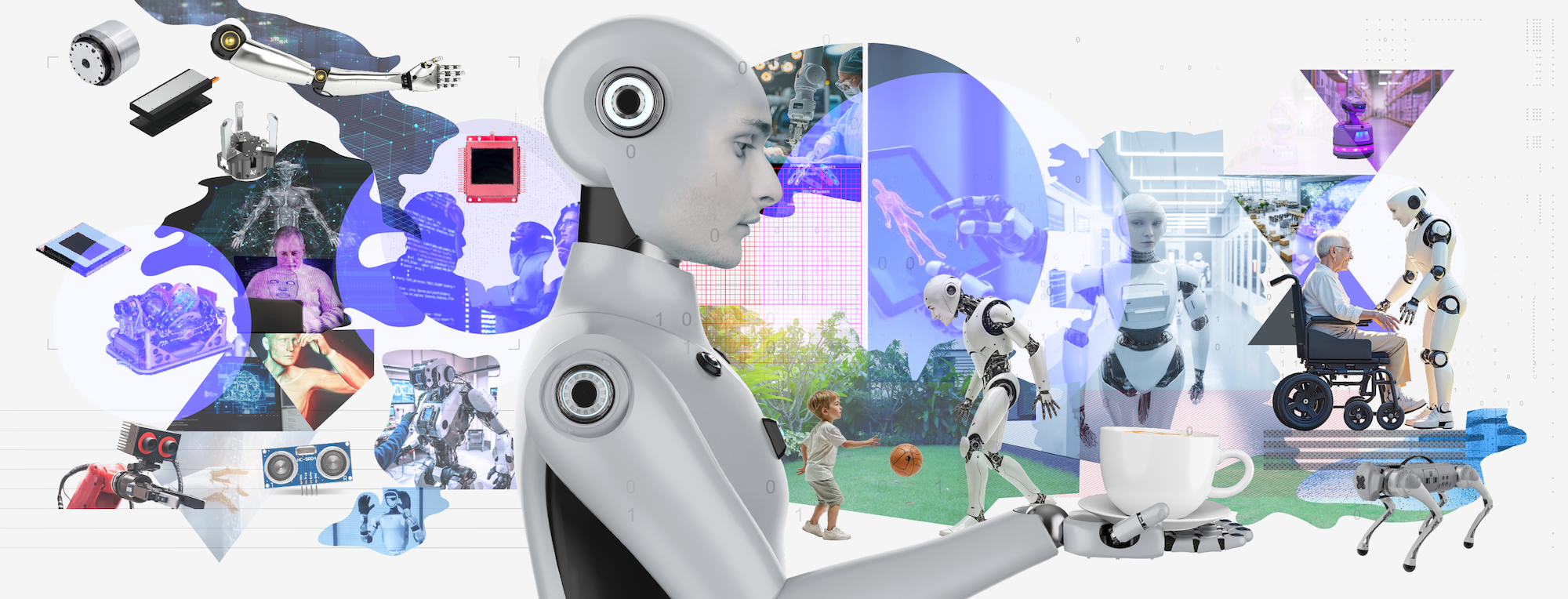How is mobile and humanoid robotics changing the service industry?
1. Introduction: At the turning point of a new service era
Mobile and humanoid robots are no longer a vision of the future, but will soon become a natural part of our everyday lives. Anyone who has seen the images of the Robot Olympics in China can guess how far development has already progressed. But the really exciting thing is not the technical demonstration, but what comes next: the step out of the euphoria phase and the inevitable trough of disillusionment into the productive mainstream.
We use the term “robotified services” to describe those services that are increasingly supported or even enabled by mobile or humanoid robots. These range from simple routine tasks to close collaboration between humans and machines to entirely new service offerings. Given that services now account for around two-thirds of global value creation, it is clear that we are talking about nothing less than the future of the world's largest economic sector.
2. Why robotics will soon become inevitable
The driving forces behind this development are obvious. In Germany, as in many other countries, there is already a shortage of hundreds of thousands of skilled workers. Society is aging, while the number of people in employment is declining. Without technological support, it will not be possible to maintain the provision of care, education, or skilled trades.
At the same time, demand is growing. Urbanization is causing cities to become increasingly dense and supply systems to reach their limits. Customers expect individualized services that are available around the clock – and at prices that cannot be achieved with human labor alone.
Technological advances have paved the way for this. Artificial intelligence, powerful sensors, better batteries, and ultra-fast networks make robots mobile, capable of learning, and networked. And society is also further along than many people think. Younger generations are growing up with digital assistants as a matter of course and find them indispensable. . And society is also further along than many people think. Younger generations are growing up with digital assistants as a matter of course and see robots not as foreign objects, but as useful helpers. Finally, the pandemic has shown us all how important it is to be able to provide resilient services even in times of crisis.
The conclusion is clear: mobile and humanoid robotics are no longer considered a gimmick, but a necessary response to the structural challenges of the service economy.
3. How big is the potential?
To understand the dimensions, it is worth taking a look at today's fundamentals. In 2024, the global service economy will have a volume of around 60.8 trillion € . In the EU, the value amounts to around 11.9 trillion, and in Germany to around 2.55 trillion. >€.
The crucial question is: What proportion of this enormous sum will be contributed by robots in 2040?
Our conservative modeling assumptions assume that between 10 and 15 percent of these service values will be contributed by robots in 2040, slightly more in high-penetration sectors and slightly less in others.
On this basis, the following potential for “robotified services” emerges (in billions of euros, at 2024 prices):
- Germany: €255–383 billion
- EU: €1,430–1,900 billion
- Worldwide: €7,290–9,120 billion
Even though there are still many unanswered questions and potential roadblocks , one thing is clear: robotified services are not a sideshow. They mark the rise of a new service paradigm that will rewrite the rules of the service economy in many industries.
4. Where changes become visible
The true impact can best be understood by looking at specific fields.
In nursing, for example, robots are not substitutes for humans, but assistants that take on routine tasks – lifting patients, measuring vital signs, or assisting with simple therapies. This allows nursing staff to devote their time to what really matters: empathy, care, and complex treatments.
In education, robots enable a new form of individualization. They accompany learners, adapt to their progress, and relieve teachers. Where large classes and scarce resources currently prevent individuality, robots can open doors.
Logistics is already showing what is possible today. Mobile robots move goods in warehouses, navigate through urban spaces, and speed up supply chains. By 2040, they will take over a large part of internal and urban transport.
The potential is also enormous in the trades and construction industry. Robots that move heavy loads or perform repetitive tasks increase productivity and make workplaces safer. The helping hand of robots makes skilled workers many times more productive.
Agriculture, in turn, is being redefined by robots. Autonomous systems are taking over harvesting, maintenance, and animal care. By 2040, “farm-as-a-service” could be a commonplace service, bookable in the same way as a car-sharing vehicle is today.
The hospitality industry is also undergoing change. Whether as a concierge in a hotel, a room service delivery person, or a kitchen assistant, robots can not only reduce costs but also create entirely new guest experiences.
And finally, the household: this is where the greatest volume may lie. Mobile and, in particular, humanoid robots that clean, cook, shop, look after pets when you are away, or simply provide company for people living alone company" or provide a sense of security, could become the next mass market – as natural as the car is today – provided that costs are rapidly reduced and regulatory frameworks and socio-cultural norms are successfully negotiated.
5. The added value for companies
Decision-makers in the service industry are faced with a crucial question: What specific benefits does the use of robotics bring to their own business?
First and foremost, it's about efficiency. Robots perform routine tasks faster, more reliably, and more cost-effectively. In many industries, the costs for certain services can be reduced by ten to twenty percent.
But efficiency is only part of the story. At least as important is the ability to scale services. What was previously limited by staff shortages and costs—such as round-the-clock care or individualized support in education—is suddenly feasible with robotics. Companies can serve more customers, offer longer service hours, and tap into markets that were previously inaccessible.
The third lever is innovation. Robots are giving rise to services that simply did not exist before. Robotics-as-a-Service makes robots flexibly available. Hybrid formats combine human expertise with robotic efficiency. Experience-oriented services create new opportunities for differentiation in the competitive environment.
Robotics is therefore not only changing the cost structure, but also opening up areas of growth and opportunities for innovation. It is a lever that goes far beyond traditional rationalization programs.
6. New patterns of value creation
Perhaps the most exciting thing is that robotics is creating completely new patterns of value creation. Services that were previously highly personnel-dependent are becoming both scalable and customizable. Human expertise and robotic efficiency are merging to create hybrid services. Platforms make it possible to offer robotics as a service—a revolution especially for small and medium-sized enterprises, which now have access to technologies that were previously unavailable to them.
7. Where the journey is headed
The development of humanoid robotics in particular can be understood as a roadmap. It starts with simple assistance systems without autonomy. In the next stage, robots react to their environment. This is followed by a phase in which they learn to adapt their actions and take on independent tasks. Later, they acquire socio-cognitive skills, recognize gestures and emotions, and are able to work with humans in teams. Finally, at the highest level, robots are so deeply embedded in cultural routines that they become natural actors in institutions.
For companies, this roadmap means that they can develop their strategies step by step—from the initial deployment of simple systems to the design of entirely new ecosystems of services.
8. Conclusion: Your robotics strategy with Z_punkt
Robotified services represent the greatest lever for the transformation of the service economy in the coming decades. They are a market that will reach double-digit trillion values worldwide. But more importantly, they offer companies the opportunity to reduce costs, expand capacity, and create entirely new markets.
The question is therefore not whether this development will happen, but how you can prepare your company for it. Z_punkt accompanies you on this journey – with in-depth foresight analyses, scenarios and roadmaps, and the design of new business models.
The crucial question is: What does your robotics strategy look like?



